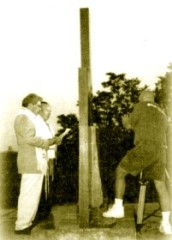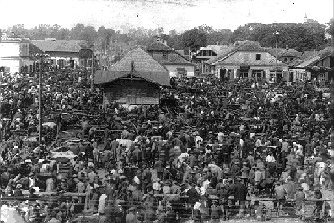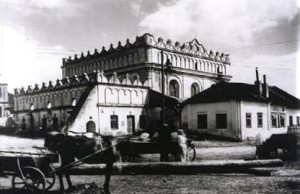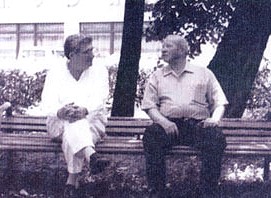|
We
see two men walking. We hear their voices as they stand before
a memorial stone, reciting the Jewish prayers for the dead.
They light candles. The words MASS GRAVE OF LUBOML'S JEWS appear on
the screen. We hear the men speak, in voice over, as they
continue to pray. We hear one man, Abe Getman, tell us he was
born in Luboml in 1926. The other man, Aaron Ziegelman, tells us he was born in
there in 1928. We hear other voices and see other Lubomlers who
talk of Luboml as it once was; a vibrant Jewish shtetl
(market town).
Abe Getman and Aaron Ziegelman
honoring
the dead
with prayers
at the memorial at the
site
where
their townspeople were executed.
|
 |
|
We dissolve to old photographs of
Luboml. Now we bring the town back to life, beginning with the
marketplace. Fade in the sounds of voices, clatter, chatter,
mooing of cows, whinnying of horses, and music. We see the busy
marketplace at full roar on a market day in 1926. We use it as the centerpiece of our documentary, as it was the
centerpiece of the life of the shtetl.
Market Square in
Luboml
on a market day in
1926. |
 |
|
Aaron and Abe appear at the site
of the former marketplace and at locations around town.
Throughout the film, people share their memories on camera and
in voice over remembering the shops, streets, the Great
Synagogue, the buildings that surrounded the market square and
its great rush of excitement. Market day ends. Daylight
fades. Night falls as we follow the Lubomlers of old back to
their homes.
The Great
Synagogue, with shtiblekh
(small prayer houses). 1930. |
 |
|
We move out
into the new day. We see what the fathers did as they go to
work, the businesses and stores, factories and
workshops. We meet those who made shoes, the water carrier,
the doctor, the printer, those who worked in the distillery,
the rich merchants and the poor laborers. We return to pick up
the children's day and follow them to school. We see young
boys in cheder (a Jewish school), the older children in
public school. We meet the Jewish teachers who taught them. We
hear about their belief, so strong in the Jewish world, that
to teach children, especially Torah, was a duty of the heart. |
|
Next we look
directly at the Jewish life of the town. Attention is paid to
The Great Synagogue, the Sabbath rituals and holidays like
Passover, Hanukah and Yom Kippur. We follow the Lubomlers as
they remember passages that meant something to them
personally like Bar Mitzvahs, weddings and funerals. We see
the regular, everyday social life of Luboml. People are seen
in the streets, boys and girls playing games, riding
bicycles and going off to the movies.
Aaron and
Abe reminisce
about
their vibrant Jewish childhood. |
 |
|
Times grow
dangerous. Anti-Semitism, which was always present, gives
birth to the Nazi threat. The Lubomlers able to leave begin to
leave. In 1939, World War II descends on Luboml. We have seen
the town at play, at work, at prayer. We have come to know
their stories, hopes, dreams and fears. Now we see their end.
A time of rapidly impending doom begins. The Germans first create a ghetto with small
killing actions ... then, a massacre. In October 1942, 4,000
Jews of Luboml are marched to pits in a killing field on the
edge of town and murdered. We come up at the monument. Aaron
and Abe finish reciting their prayers. Evening shadows fall.
Aaron and Abe and the Luboml landsmen recall the heart and
soul of the town and the claim it still holds on them. We see
this as they look at the faces of people lost. Aaron and Abe
turn and leave. We watch them walk together into the fading
light of dusk. Before credits roll, we learn only 51 Jewish
citizens of Luboml survived the Holocaust. Luboml is one of
thousands of shtetlach destroyed in the same way.
Not one Jew lives in Luboml
today. |
|
|